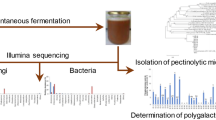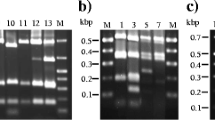Summary
Forty-three isolates of Gram-negative, mesophilic, non-spore-forming anaerobic cellulolytic bacteria were obtained from (i) an anaerobic reactor treating waste water from an integrated paper mill and (ii) an anaerobic sewage-sludge digestor. These isolates were studied for carbohydrate fermentation and fermentation products. By numerical techniques, 22 isolates could be placed in two groups: group A (10 isolates) and group B (12 isolates). The isolates belonging to group A showed degradation of filter paper in 2–7 days. They were slightly-curved long rods and similar toBacteroides cellulosolvens andAcetivibrio cellulolyticus. Acetic acid was produced as major product. The bacteria also produced ethanol, isobutanol, pyruvic and lactic acids. Group B strains degraded filter paper in 4–5 weeks. They were short rods and produced propionic, lactic, succinic and acetic acids as fermentation products. The remaining 21 isolates could disintegrate filter paper in 2–5 weeks. They showed variable fermentation patterns, both as to fermentable carbohydrates and end products. Except for one isolate, which showed obvious similarity toButyrivibrio fibrisolvens, the isolate differed distinctly from reference strains of ruminai origin.
Résumé
43 souches de bactéries cellulolytiques Gram-négatives, mésophiles, non-sporulantes, et anaérobies ont été isolées à partir (A) d'un réacteur anaérobie traitant l'eau résiduaire d'une usine intégrale de pâte à papier et (B) de digesteurs anaérobies de boues d'égout. Ces souches ont été étudiées quant à leurs propriétés de fermenter les hydrates de carbone et quant à leurs produits de fermentation. Des techniques numériques ont permis de classer 22 de ces souches dans deux groupes: le groupe A (10 souches) et le groupe B (12 souches). Les souches appartenant au groupe A dégradaient le papier filtre en 2 à 7 jours. Elles se présentaient sous la forme de longs bâtonnets curvilignes et ressemblaient àBacteroides cellulosolvens et àAcetivibrio cellulolyticus. Le metabolite majeur était l'acide acétique. Elles produisaient aussi de l'éthanol, de l'iso-butanol, et des acides pyruvique et lactique. Les souches appartenant au groupe B dégradaient le papier filtre en 4 à 5 semaines. Elles se présentaient sous la forme de bâtonnets courts et produisaient, comme métabolites, les acides propionique, lactique, succinique et acétique. Les 21 souches restantes dégradaient le papier filtre en 2 à 5 semaines. Elles présentaient des profils de fermentation variables tant en ce qui concernait les hydrates de carbone fermentés que les produits finaux. A part une souche qui présentait une similitude évidente avecButyrivibrio fibrisolvens, ces souches différaient de façon marquée d'avec les souches de référence du rumen.
Similar content being viewed by others
References
Balch, W.E., Fox, G.E., Magrum, L.J., Woese, C.R. &Wolfe, R.S. 1979 Methanogens: reevaluation of a unique biological group.Microbiological Reviews 43, 260–296.
Bradon, D.G. 1979 Isolation of an anaerobic cellulolytic mixed culture.European Journal of Applied Microbiology and Biotechnology 7, 281–288.
Deutsche Sammlung von Mikroorganism (DSM) (German Collection of Microorganisms), 3rd edn, pp. 291–292. Göttingen.
Hobson, P.N. 1969 Rumen bacteria.Methods in Microbiology 3B, 133–149.
Holdeman, L. V. &Moore, W.E.C. 1972Anaerobe Laboratory Manual. Blacksburg: Virginia Polytechnic Institute and State University Anaerobe Laboratory.
Hungate, R.E. 1950 The anaerobic mesophilic cellulolytic bacteria.Bacteriological Reviews 14, 1–49.
Hungate, R.E. 1957 Microorganisms in the rumen of cattle fed a constant ration.Canadian Journal of Microbiology 3, 289–311.
Krieg, N.R. &Holt, J.G. 1984Bergey's Manual of Systematic Bacteriology, Vol.1, 964 pp. London: Williams & Wilkins.
Madden, R.H. 1983 Isolation and characterization ofClostridium stereovarium sp. nov., cellulolytic thermophile.International journal of Systematic Bacteriology 30, 840.
Maki, L.R. 1954 Experiments on the microbiology of cellulose decomposition in a municipal sewage plant.Antonie van Leeuwenhoek Journal of Microbiology Serology 20, 188–200.
Miller, T.L. &Wolin, M.J. 1974 A serum bottle modification of the Hungate technique for cultivating obligate anaerobes.Applied Microbiology 27, 985–987.
Murray, W.D., Sowden, L.C. &Colvin, J.R. 1984Bacteroides cellulosolvens sp. nov., a cellulolytic species from sewage sludge.International Journal of Systematic Bacteriology 34, 185–187.
Patel, G.B., Khan, A.W., Agrew, B.J. &Colvin, J.R. 1980 Isolation and characterization of an anaerobic cellulolytic microorganism,Acetivibrio cellulolyticus gen. nov. sp. nov.International Journal of Systematic Bacteriology 30, 179–185.
Petitdemange, E., Caillet, F., Giallo, J. &Gaudin, C. 1984Clostridium cellulolyticum sp. nov., a cellulolytic mesophilic species from decayed grass.International Journal of Systematic Bacteriology 34, 155–159.
Rahmatullah, M., Rahman, A., Chowdhury, A.A. &Rashid, M.A. 1979 Anaerobic digestion of jute — stick powder by a mesophilic cellulolyticClostridium species.Journal of Fermentation Technology 57, 117–123.
Rizzo, A. 1980. Rapid gas-chromatographic method for identification of metabolic products of anaerobic bacteria.Journal of Clinical Microbiology 11, 418–421.
Sleat, R. &Mah, R.A. 1985Clostridium populeti sp. nov., a cellulolytic species from a woodybiomass digestor.International Journal of Systematic Bacteriology 35, 160–163.
Sleat, R., Mah, R.A. &Robinson, R. 1984 Isolation and characterization of an anaerobic, cellulolytic bacterium,Clostridium cellulovorans sp. nov.Applied Environmental Microbiology 48, 88–93.
Stewart, C.S., Paniagua, C., Dinsdale, D., Cheng, K.J. &Garrow, S.H. 1981 Selection, isolation and characteristics ofBacteroides succinogenes from the rumen of a cow.Applied Environmental Microbiology 41, 504–510.
Thomas, K.Ng., Aric Ben-Bassat &Zeikus, J.G. 1981 Ethanol production by Thermophilic Bacteria: Fermentation of cellulosic substrate by cocultures ofClostridium thermocellum andC. thermohydrosulfurium.Applied Environmental Microbiology 41, 1337–1343.
van der Toorn, J.J.T.K. &Gylswyk, N.O. 1980 Description and designation of a neotype strain ofEubacterium cellulosolvens (Cellobacterium cellulosolvens Bryant, Small Bouma and Robinson) Holdeman and Moore.International Journal of Systematic Bacteriology 36, 275–277.
Warshaw, J.E., Leschine, S.B. &Canale-parola, E. 1985 Anaerobic cellulolytic bacteria from wetwood of living trees.Applied Environmental Microbiology 50, 807–811.
Author information
Authors and Affiliations
Rights and permissions
About this article
Cite this article
Nitisinprasert, S., Temmes, A. & Gyllenberg, H.G. Characterization of anaerobic non-spore-forming bacteria in municipal sewage sludge and integrated paper-mill waste water. World J Microbiol Biotechnol 5, 67–76 (1989). https://doi.org/10.1007/BF01724961
Received:
Accepted:
Issue Date:
DOI: https://doi.org/10.1007/BF01724961




